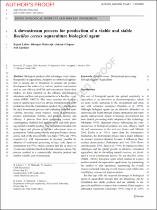 ResearchSpace
ResearchSpace
Downstream process for production of a viable and stable Bacillus cereus aquaculture biological agent
JavaScript is disabled for your browser. Some features of this site may not work without it.
- ResearchSpace
- →
- Research Publications/Outputs
- →
- Journal Articles
- →
- View Item
| dc.contributor.author |
Lalloo, Rajesh

|
|
| dc.contributor.author |
Maharajh, Dheepak M

|
|
| dc.contributor.author |
Görgens, J

|
|
| dc.contributor.author |
Gardiner, N

|
|
| dc.date.accessioned | 2010-10-11T11:24:23Z | |
| dc.date.available | 2010-10-11T11:24:23Z | |
| dc.date.issued | 2010-03 | |
| dc.identifier.citation | Lalloo, R, Maharajh, D, Görgens, J and Gardiner, N. 2010. Downstream process for production of a viable and stable Bacillus cereus aquaculture biological agent. Applied Microbiology and Biotechnology, Vol. 86(2), pp 499-508 | en |
| dc.identifier.issn | 0175-7598 | |
| dc.identifier.uri | http://www.springerlink.com/content/353252416857p725/fulltext.pdf | |
| dc.identifier.uri | http://hdl.handle.net/10204/4469 | |
| dc.description | Copyright: 2010 Springer. This is the author's pre print version of the work. The definitive version is published in Applied Microbiology and Biotechnology, Vol. 86(2), pp 499-508 | en |
| dc.description.abstract | Biological products offer advantages over chemotherapeutics in aquaculture. Adoption in commercial application is lacking due to limitations in process and product development that address key end user product requirements such as cost, efficacy, shelf life and convenience. In previous studies, we have reported on the efficacy, physiological robustness and low-cost spore production of a Bacillus cereus isolate (NRRL 100132). This study examines the development of suitable spore recovery, drying, formulation and tablet production from the fermentation product. Key criteria used for such downstream process unit evaluation included spore viability, recovery, spore balance, spore re-germination, product intermediate stability, end product stability and efficacy. A process flow sheet comprising vertical tube centrifugation, fluidised bed agglomeration and tablet pressing yielded a suitable product. The formulation included corn steep liquor and glucose to enhance subsequent spore regermination. Viable spore recovery and spore balance closure across each of the process units was high (>70% and >99% respectively), with improvement in recovery possible by adoption of continuous processing at large scale. Spore regermination was 97%, whilst a product half-life in excess of 5 years was estimated based on thermal resistance curves. The process resulted in a commercially attractive product and suitable variable cost of production. | en |
| dc.language.iso | en | en |
| dc.publisher | Springer | en |
| dc.relation.ispartofseries | Journal Article | en |
| dc.subject | Bacillus cereus | en |
| dc.subject | Downstream processing | en |
| dc.subject | Biological agent | en |
| dc.subject | Aquaculture | en |
| dc.title | Downstream process for production of a viable and stable Bacillus cereus aquaculture biological agent | en |
| dc.type | Article | en |
| dc.identifier.apacitation | Lalloo, R., Maharajh, D. M., Görgens, J., & Gardiner, N. (2010). Downstream process for production of a viable and stable Bacillus cereus aquaculture biological agent. http://hdl.handle.net/10204/4469 | en_ZA |
| dc.identifier.chicagocitation | Lalloo, Rajesh, Dheepak M Maharajh, J Görgens, and N Gardiner "Downstream process for production of a viable and stable Bacillus cereus aquaculture biological agent." (2010) http://hdl.handle.net/10204/4469 | en_ZA |
| dc.identifier.vancouvercitation | Lalloo R, Maharajh DM, Görgens J, Gardiner N. Downstream process for production of a viable and stable Bacillus cereus aquaculture biological agent. 2010; http://hdl.handle.net/10204/4469. | en_ZA |
| dc.identifier.ris | TY - Article AU - Lalloo, Rajesh AU - Maharajh, Dheepak M AU - Görgens, J AU - Gardiner, N AB - Biological products offer advantages over chemotherapeutics in aquaculture. Adoption in commercial application is lacking due to limitations in process and product development that address key end user product requirements such as cost, efficacy, shelf life and convenience. In previous studies, we have reported on the efficacy, physiological robustness and low-cost spore production of a Bacillus cereus isolate (NRRL 100132). This study examines the development of suitable spore recovery, drying, formulation and tablet production from the fermentation product. Key criteria used for such downstream process unit evaluation included spore viability, recovery, spore balance, spore re-germination, product intermediate stability, end product stability and efficacy. A process flow sheet comprising vertical tube centrifugation, fluidised bed agglomeration and tablet pressing yielded a suitable product. The formulation included corn steep liquor and glucose to enhance subsequent spore regermination. Viable spore recovery and spore balance closure across each of the process units was high (>70% and >99% respectively), with improvement in recovery possible by adoption of continuous processing at large scale. Spore regermination was 97%, whilst a product half-life in excess of 5 years was estimated based on thermal resistance curves. The process resulted in a commercially attractive product and suitable variable cost of production. DA - 2010-03 DB - ResearchSpace DP - CSIR KW - Bacillus cereus KW - Downstream processing KW - Biological agent KW - Aquaculture LK - https://researchspace.csir.co.za PY - 2010 SM - 0175-7598 T1 - Downstream process for production of a viable and stable Bacillus cereus aquaculture biological agent TI - Downstream process for production of a viable and stable Bacillus cereus aquaculture biological agent UR - http://hdl.handle.net/10204/4469 ER - | en_ZA |





